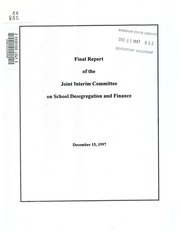Louisiana School Desegregation: Justice Department's Final Order

Table of Contents
The History Leading to the Final Order
The fight for desegregation in Louisiana was a protracted and arduous battle, spanning decades of legal challenges and resistance.
The Pre-Brown v. Board Era:
Before the landmark Brown v. Board of Education Supreme Court case in 1954, Louisiana schools were rigidly segregated under de jure segregation. This legally mandated separation was enforced through a complex web of Jim Crow laws and discriminatory practices.
- Segregated facilities: Black and white students attended entirely separate schools, with vastly unequal resources allocated to each.
- Unequal funding: Black schools were consistently underfunded, lacking adequate resources, qualified teachers, and updated facilities.
- Plessy v. Ferguson's legacy: The 1896 Plessy v. Ferguson ruling, upholding "separate but equal," legitimized segregation and provided a legal framework for its continuation.
- Limited access to education: Many Black students faced significant barriers to education, including limited access to high schools and vocational training.
The Post-Brown Era and Continued Resistance:
Following Brown v. Board, Louisiana, like many Southern states, engaged in "massive resistance" to desegregation. This resistance manifested in various forms:
- School closures: Some districts closed schools rather than integrate them.
- White flight: White families moved their children to private schools to avoid integration.
- Token integration: Minimal desegregation efforts often involved integrating only a small number of Black students.
- Legal challenges: Continued legal battles aimed to delay or obstruct the implementation of desegregation.
The federal government, through the Department of Justice (DOJ), gradually increased its involvement, initiating lawsuits and issuing court orders to compel compliance with desegregation mandates.
The Justice Department's Involvement:
The DOJ played a crucial role in enforcing desegregation in Louisiana, using its authority to:
- File lawsuits: The DOJ brought numerous lawsuits against Louisiana school districts that refused to desegregate.
- Issue court orders: Federal courts issued orders mandating desegregation plans, including student assignment policies and resource allocation.
- Monitor compliance: The DOJ monitored school districts to ensure compliance with court orders and imposed sanctions for non-compliance.
- Escalating pressure: The federal government’s persistent legal actions and pressure steadily increased the pressure on Louisiana school systems to desegregate.
Key Provisions of the Final Order
The Justice Department's final order contained several crucial provisions aimed at achieving meaningful desegregation in Louisiana schools.
Specific Requirements for Desegregation:
The order detailed specific mandates for school districts, including:
- Student assignment policies: These policies were designed to achieve racial balance in schools by addressing discriminatory practices in student assignment.
- Faculty diversity requirements: The order addressed the historical lack of diversity in teaching staff, mandating efforts to recruit and retain qualified minority teachers.
- Equitable resource allocation: The order ensured fair distribution of resources among schools, addressing historical disparities in funding and facilities.
- Monitoring mechanisms: Robust monitoring systems were established to track progress and ensure compliance with the order's provisions.
Addressing the Legacy of Segregation:
The order also recognized the need to address the lasting effects of segregation on Louisiana's schools. This included:
- Compensatory education: Programs were implemented to provide additional support for disadvantaged students, bridging the achievement gap.
- Initiatives to promote academic achievement: The order focused on improving educational outcomes for all students, especially those from historically disadvantaged communities.
- Efforts to foster diversity: Strategies were developed to create more inclusive learning environments that celebrated diversity and promoted understanding.
Enforcement and Oversight Mechanisms:
The order established mechanisms to ensure compliance and address non-compliance:
- Reporting requirements: School districts were required to submit regular reports detailing their progress toward desegregation.
- Periodic reviews: Independent reviews were conducted to assess the effectiveness of desegregation efforts.
- Sanctions for non-compliance: Consequences were outlined for school districts failing to comply with the court's orders.
- Judicial oversight: The courts retained the authority to monitor and enforce compliance with the order.
Long-Term Impact and Ongoing Challenges
The Justice Department's final order had a significant impact on Louisiana schools, but challenges remain.
Successes and Limitations:
While the order led to improvements in racial balance in some schools and increased opportunities for minority students, significant challenges persisted:
- Racial integration: While some progress was made, complete racial integration remains elusive in many areas.
- Academic achievement disparities: The achievement gap between white and minority students continues to exist, reflecting the lasting impact of historical inequities.
- School funding disparities: Funding inequalities between schools serving predominantly minority populations and those serving predominantly white populations often persist.
- De facto segregation: Residential segregation has led to de facto segregation in some areas, even in the absence of formal segregation policies.
The Ongoing Struggle for Educational Equity:
The fight for educational equity in Louisiana continues. This requires:
- Addressing systemic inequalities: Systemic racism and inequities within the education system must be actively addressed.
- Promoting inclusive education: Creating inclusive learning environments that value diversity and cater to all students' needs is crucial.
- Fostering a diverse and equitable learning environment: Efforts must focus on building a welcoming and supportive environment for all students, regardless of race or background.
Conclusion: Louisiana School Desegregation – A Continued Journey
The Justice Department's final order on Louisiana school desegregation represented a landmark step toward dismantling a deeply ingrained system of racial inequality. While significant progress has been made, the legacy of segregation continues to cast a shadow on educational opportunities in Louisiana. The order's provisions, including student assignment policies, resource allocation, and monitoring mechanisms, aimed to address the systemic issues that perpetuate educational inequities. However, achieving true desegregation in Louisiana schools requires ongoing commitment to addressing systemic inequalities, promoting inclusive education, and ensuring equitable access to resources and opportunities for all students. We must continue to learn from the past and work toward a future where all students in Louisiana have the opportunity to receive a quality education, regardless of their race or background. Learn more about the history of Louisiana school desegregation efforts and support initiatives promoting educational equity in Louisiana today.

Featured Posts
-
 Daur Ulang Cangkang Telur Cara Kreatif Mengolah Limbah Rumah Tangga Menjadi Pupuk Alami
May 03, 2025
Daur Ulang Cangkang Telur Cara Kreatif Mengolah Limbah Rumah Tangga Menjadi Pupuk Alami
May 03, 2025 -
 Trump Argues Tariffs Unreviewable In Court Case
May 03, 2025
Trump Argues Tariffs Unreviewable In Court Case
May 03, 2025 -
 Bbcs 1bn Income Drop Unprecedented Challenges Ahead
May 03, 2025
Bbcs 1bn Income Drop Unprecedented Challenges Ahead
May 03, 2025 -
 The Untold Story How Beijing Manages The Narrative Of The Trade War
May 03, 2025
The Untold Story How Beijing Manages The Narrative Of The Trade War
May 03, 2025 -
 Reform Uks Agricultural Plan A Detailed Examination
May 03, 2025
Reform Uks Agricultural Plan A Detailed Examination
May 03, 2025
